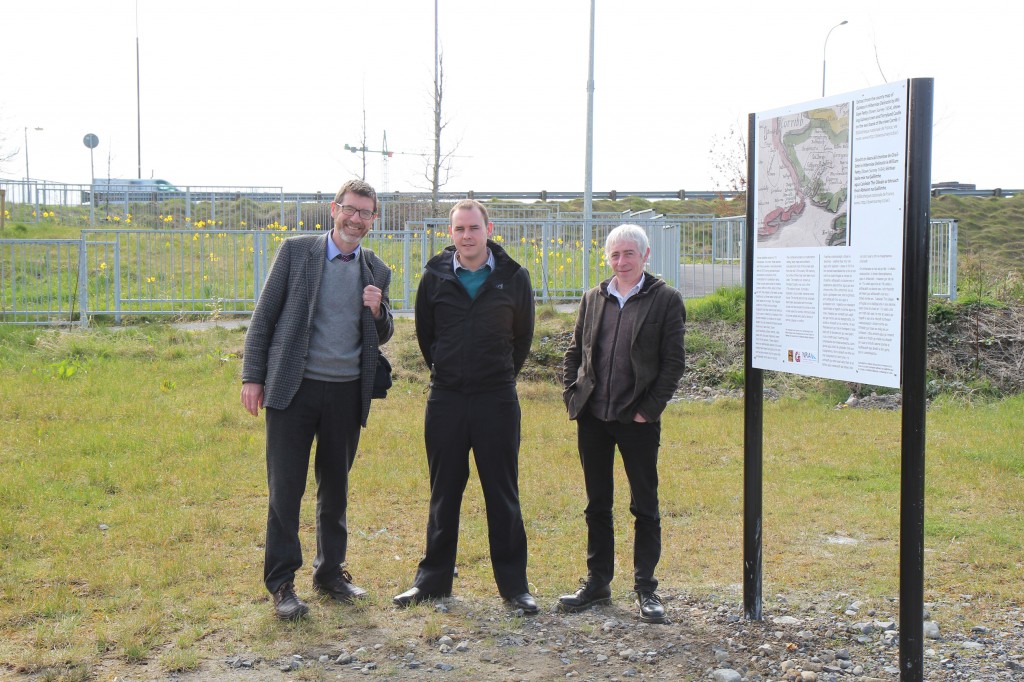Unveiling of archaeological sign at Terryland

Brian Burke (Galway City Council), Declan Moore (Moore Group) and Jerry O’Sullivan (Galway County Council) attend the unveiling of a new archaeological sign at Terryland.
Galway City Council unveiled the sign commemorating the discovery of the skeletal remains adjacent to Terryland Castle which were excavated in 2013 by archaeologists from Moore Group. The remains were uncovered at the site when Galway City Council’s Transportation Unit began to install a pedestrian and cycle ramp off the Quincentennial Bridge down to the Dyke Road at Terryland in early 2013.
Moore Group, along with an osteo-archaeologist, Linda Lynch were engaged to investigate the finds. The Galway City Council’s heritage office and engineers, along with the National Roads Authority archaeologist worked in close conjunction with the site archaeologist and the licensing authorities in the National Monuments Service and National Museum of Ireland to facilitate the recovery of the finds.
Human skeletal remains of ten individuals – four men, three women and three juveniles – were discovered buried without coffins in shallow graves. All the burials were orientated east west – however three of the individuals, contrary to traditional practice, were interred with their heads to the east,indicating that they were buried without much care or ceremony. Analysis of the bones revealed no evidence of violent deaths and their profiles do not fit with combatants dying in a military action. What the bones do tell us is a general tale of hardship during these people’s short lives.
Some post-medieval pottery sherds, nails, glass and clay pipe fragments were found in the graves. These objects were not deliberately placed but would simply have been lying about the site and became mixed into the grave fills accidentally at the time of burial. The combined evidence of radiocarbon dating, early maps and artefacts indicates that most of the burials had a likely convergence in the 17th century, but a few of them may have been much older.
The nearby ruin, known as Terryland Castle, was once a fine 17th-century house. It probably replaced a much older, medieval tower house. The burial ground may originally have been associated with the tower house and was reused from time to time in later years for hurried, informal burials of poorer people who died in times of famine, plague or conflict.
Ireland in the 17th century was a dangerous place. From the Confederate Wars (1641-49), through the Cromwellian conquest (1649-53) and the Wars of the Two Kings (1689-1691), the civilian population endured a lasting tumult that decimated the population. Given the scale of the calamities endured by the population it is reasonable to conclude that many individuals deprived of their homes, ravaged by war, disease and hunger died prematurely, were buried often in haste, in unconsecrated ground and with little rite or ritual.
The unusual burial positions and the lack of coffins suggests that the burials in Terryland do not represent a traditional cemetery for the community, but rather served a more immediate function for the disposal of the dead in a period of stress that disrupted the normal functions of society. Rather than attempting to tie the demise of these individuals into a known historical event e.g. the 1691 skirmish at the nearby castle, it is more likely that their premature deaths were caused not by the swift violence of war but by the equally brutalising and fatal consequences of it.
For more information see our post here: http://www.mooregroup.ie/2013/11/dyke-road-remains/
This entry was posted on Wednesday, April 1st, 2015 at 2:16 pm. It is filed under About Archaeology, News and tagged with archaeological consultants, archaeological consultants galway, excavation, skeletons.
You can follow any responses to this entry through the RSS 2.0 feed.



